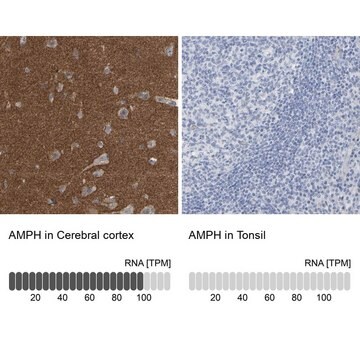추천 제품
생물학적 소스
mouse
Quality Level
결합
FITC conjugate
항체 형태
purified immunoglobulin
항체 생산 유형
primary antibodies
클론
CY-90, monoclonal
형태
buffered aqueous solution
종 반응성
wide range
기술
direct immunofluorescence: 1:100 using formalin-fixed, paraffin-embedded sections of human or animal tissues
immunohistochemistry (formalin-fixed, paraffin-embedded sections): suitable
동형
IgG1
배송 상태
dry ice
저장 온도
−20°C
타겟 번역 후 변형
unmodified
유전자 정보
human ... KRT18(3875) , KRT18(3875)
유사한 제품을 찾으십니까? 방문 제품 비교 안내
일반 설명
Broadly keratins are grouped into two types on the basis of their biochemical and immunological properties: Type II keratins are a family of basic proteins identified as K1 to K8, whereas type I keratins consists of K9 to K20, belong to the acidic group. It belongs to type I acrylic sub-family and is differentially expressed in various human tissues.
FITC Monoclonal Anti-Cytokeratin Peptide 18 is a purified mouse monoclonal antibody conjugated with fluorescein isothiocyanate (FITC) isomer I. Monoclonal Anti-Cytokeratin Peptide 18 (mouse IgG1 isotype) is derived from the CY-90 hybridoma produced by the fusion of mouse myeloma cells and splenocytes of immunized BALB/c mice. Cytokeratin 18 (CYK18) is a 45 kDa polypeptide, differentially expressed in various human tissues.
면역원
human epidermal carcinoma A-431 and MCF-7 human breast cancer cell lines.
애플리케이션
Monoclonal Anti-Cytokeratin Peptide 18 FITC antibody produced in mouse has been used in:
- direct immunofluorescent staining
- immunohistochemistry
- double immunofluorescence
- immunocytochemical and immuno?electron microscopic localization of keratins
Monoclonal Anti-Cytokeratin Peptide 18-FITC antibody:
- is suitable for immunohistochemistry to identify renal tubular epithelial cells in the extrarenal cells regeneration during acute renal failure
- is suitable for immunocytochemical and immuno-electron microscopic localisation of keratins in human materno-foetal interaction zone
- may be used for single or double labeling procedures
생화학적/생리학적 작용
Cytokeratins also called keratins (Ks) according to the new nomenclature system.These are known to be the major structural proteins of epithelial cells. It is heteropolymeric in nature i.e. in cells more than one keratin protein is always present. It belongs to type I acrylic sub-family and is differentially expressed in various human tissues. It maintains the structural integrity of extra-embryonic membrane epithelia. Broadly keratins are grouped into two types on the basis of their biochemical and immunological properties: Type II keratins are a family of basic proteins identified as K1 to K8, whereas type I keratins consists of K9 to K20, belong to the acidic group.
Monoclonal anti-cytokeratins are specific markers of epithelial cell differentiation and have been widely used as tools in tumor identification and classification. FITC Monoclonal Anti-Cytokeratin Peptide 18 is a chain specific antibody which can facilitate typing of normal, metaplastic and neoplastic cells. Cytokeratin 18 (CYK18) is a cytoskeletal protein associated with apoptosis. CK-18 is considered as a promising plasma biomarker to identify patients with HELLP (hemolysis, elevated liver enzymes, low platelets) syndrome.
물리적 형태
Supplied as a solution in 0.01 M phosphate buffered saline, pH 7.4, containing 1% BSA with 15 mM sodium azide as a preservative.
면책조항
Unless otherwise stated in our catalog or other company documentation accompanying the product(s), our products are intended for research use only and are not to be used for any other purpose, which includes but is not limited to, unauthorized commercial uses, in vitro diagnostic uses, ex vivo or in vivo therapeutic uses or any type of consumption or application to humans or animals.
적합한 제품을 찾을 수 없으신가요?
당사의 제품 선택기 도구.을(를) 시도해 보세요.
Storage Class Code
10 - Combustible liquids
Flash Point (°F)
Not applicable
Flash Point (°C)
Not applicable
시험 성적서(COA)
제품의 로트/배치 번호를 입력하여 시험 성적서(COA)을 검색하십시오. 로트 및 배치 번호는 제품 라벨에 있는 ‘로트’ 또는 ‘배치’라는 용어 뒤에서 찾을 수 있습니다.
Sandeep Gupta et al.
Kidney international, 62(4), 1285-1290 (2002-09-18)
Recovery of renal function following acute tubular necrosis (ATN) is dependent on the replacement of necrotic tubular cells with functional tubular epithelium. The source of these new tubular cells is thought to be resident renal tubular cells. The discovery of
C Lampron et al.
The Journal of biological chemistry, 262(10), 4893-4898 (1987-04-05)
Differentiation of F9 embryonal carcinoma cells by retinoic acid treatment results in extraembryonic endoderm-like cells. The effects of this process on the protein composition of the intermediate filaments were studied by two-dimensional gel electrophoresis and by immunoblotting. By this approach
Immunofluorescence confocal laser scanning microscopy and immuno-electron microscopic identification of keratins in human materno-foetal interaction zone
Ahenkorah J, et al.
Journal of Cellular and Molecular Medicine, 13(4), 735-748 (2009)
Cytokeratin 18 is expressed on the hepatocyte plasma membrane surface and interacts with thrombin-antithrombin complexes
Wells MJ, et al.
The Journal of Biological Chemistry, 272(45), 28574-28581 (1997)
Kalipso Halkidou et al.
The Prostate, 59(2), 177-189 (2004-03-26)
Histone deacetylase 1 (HDAC1) is a co-repressor involved in differentiation and proliferation control. It is upregulated in malignant compared to benign tissue, and targets a number of transcription factors including p53. By immunohistochemistry, HDAC1 protein expression was investigated in human
자사의 과학자팀은 생명 과학, 재료 과학, 화학 합성, 크로마토그래피, 분석 및 기타 많은 영역을 포함한 모든 과학 분야에 경험이 있습니다..
고객지원팀으로 연락바랍니다.








